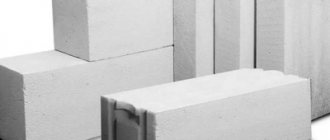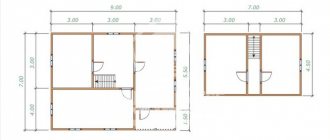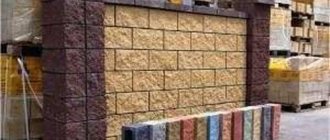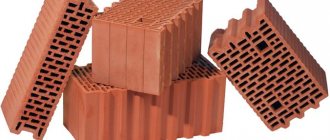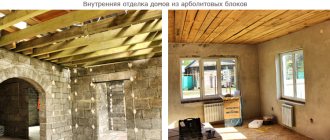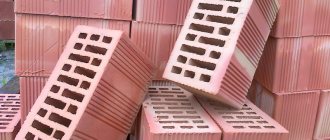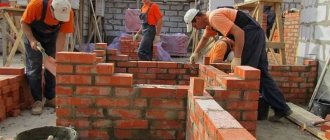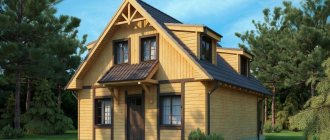Let's figure out what the features of materials such as aerated concrete and gas silicate are, what the difference is between them, and which one is more suitable for building a house. Aerated concrete and gas silicate blocks are similar in appearance, so making a choice between them is not so easy.
There are differences in the compositions, manufacturing technologies and some properties of these materials. Read to the end and compare their technical characteristics to understand the advantages and subtleties of using aerated concrete and gas silicate.
House made of aerated concrete blocks Source country-housebuilding.rf
What is aerated concrete and gas silicate
These building materials are varieties of cellular concrete, which is characterized by a porous structure and low density. Durable and lightweight aerated concrete blocks have increased thermal insulation properties. The low thermal conductivity of cellular concrete is due to the presence of numerous voids filled with air.
Many people have a question about the difference between aerated concrete and gas silicate, what is the difference between them.
Both materials contain cement, sand, lime, gas-forming agents (aluminum paste or powder) and water. The difference is in the ratio of components and block manufacturing technologies.
Aerated concrete is a mixture whose main component is Portland cement. When the concrete mass, to which a gas-forming agent is added, hardens, spherical voids with a diameter of 1-3 mm are formed in it. The reason for their appearance is the release of hydrogen during a chemical reaction between aluminum and lime.
The composition of aerated concrete includes:
- Portland cement – 50-70%;
- Sand – 20-40%;
- Lime – 1-5%;
- Gas-forming agent – 0.04-0.09%;
- Water – 0.25-0.8%.
Construction of a house from aerated concrete blocks Source stroitelstvo-remont-sochi.ru
Gas silicate has a lime-silica binder base, consisting of silicate sand (up to 60%) and lime (24%). Aluminum powder or paste is also added to form cells.
Due to the difference in the content of cement and lime, products made from these materials differ in color. Aerated concrete blocks have a gray tint, while gas silicate blocks are white.
Construction of a wall from gas silicate Source blockexpert.ru
Manufacturing method
The main raw material used for the production of porous concrete is cement.
In the production of gas silicate it is replaced by lime. At the initial stage, the main component is mixed with water and sand cleared of impurities. A gas-forming substance (aluminum powder) is added to the finished composition. The finished mixture is poured into molds.
Expert opinion Vitaly Kudryashov builder, aspiring author
Ask a Question
The subsequent stage of processing aerated concrete occurs according to different principles, resulting in 2 building materials with different technical characteristics.
The mold with the mixture is placed in an autoclave oven, where it is dried under high pressure. During hardening, gases are released, then many cells are formed in the structure of the block through which vapors escape. This technique increases strength and density. The resulting material is actively used in construction as the main material in the construction of load-bearing walls.
The second method of making aerated concrete is to dry it naturally. The resulting cellular block is used in the field of construction and finishing works, in particular, for insulating building facades.
Expert opinion Vitaly Kudryashov builder, aspiring author
Ask a Question
Healthy! In fact, there are concepts on the market: aerated concrete/gas silicate, autoclaved, non-autoclaved. Confusion in terms is most often caused by incompetent sellers who do not attach importance to the names of different materials.
Technologies for manufacturing blocks from aerated concrete and gas silicate
To understand the difference between aerated concrete and gas silicate, it is necessary to take into account the difference in the methods of manufacturing such materials.
To obtain cellular concrete, 2 technologies are used: autoclave and non-autoclave.
In the non-autoclave production of porous blocks, solidification of the mass after adding a gas-forming agent occurs under natural conditions, without additional processing. It takes 28 days for the concrete to completely harden.
Autoclave technology allows you to speed up this process up to 12-15 hours by maintaining the concrete mass under a pressure of 8-14 atm at temperatures up to 175-190˚C.
The advantages of autoclave technology are:
- Possibility of giving gas blocks an exact geometric shape and standard dimensions;
- More uniform distribution of voids, enhancing heat and sound insulation;
- Increasing the hardness of blocks, reducing the likelihood of shrinkage and cracking of the material.
Warning! A significant disadvantage is the increased fragility of blocks processed in an autoclave. Special care is required when transporting and stacking them. To secure heavy objects on walls made of autoclaved aerated concrete, only anchor bolts with special spacers are suitable.
Reliable fastenings for aerated concrete walls Source eyecorrector.ru
The advantages of non-autoclave blocks are lower hygroscopicity and lower price.
Aerated concrete is made using both methods.
For the production of gas silicate, only autoclave technology is used.
See also: Catalog of companies that specialize in the construction of aerated concrete houses
Array structure
Gas silicate and aerated concrete have another distinctive feature - hygroscopicity. The increased hygroscopicity of gas silicate contributes to the saturation of the concrete mass with moisture, which promotes the gradual destruction of concrete under the influence of temperature changes. Aerated concrete has increased resistance to moisture absorption and has a more durable structure of the concrete mass. It is easy to conduct an experiment by immersing each of these materials in water.
Despite the varying degrees of hygroscopicity, the blocks require protection of the cellular surface with plaster. Premises built from cellular concrete provide a comfortable temperature regime and a microclimate favorable for living.
General advantages and disadvantages of aerated concrete and gas silicate
Aerated concrete or gas silicate have the same structure, due to which they have the following common advantages:
- Low thermal conductivity coefficient - from 0.09 W/m˟С (For comparison, it can be noted that for brick this figure is 0.5-0.8 W/m˟С).
- Good frost resistance (50 or more defrosting cycles).
- Lightness, strength, environmental friendliness, fire safety.
- Ease of processing blocks (cutting, grinding). A saw is used to cut aerated concrete and gas silicate.
Cutting aerated concrete blocks using a saw Source mtdata.ru
- Rapid formation of masonry.
Common disadvantages of aerated concrete and gas silicate are:
- The ability of porous blocks to absorb moisture well, the need to use special coatings to protect walls from dampness.
- Increased risk of damage to aerated blocks during transportation, storage and laying of walls.
- Possibility of shrinkage of materials by 1-3 mm as they dry. This process leads to a decrease in the strength of the masonry, the formation of cracks in the walls and the destruction of the plaster.
- Poor adhesion of concrete to binding materials used in creating masonry and finishing walls made of aerated blocks. There is a need to use adhesives with increased adhesion.
Damaged gas silicate blocks Source ytimg.com
Comparing characteristics
- The main difference between gas silicate and gas block is its higher thermal insulation and strength qualities due to the uniform placement of hollow cells throughout the volume of the finished product.
- But in terms of indicators such as strength and fire resistance, it is aerated concrete that is ahead. And although increased strength leads to increased weight, which creates additional loads on the foundation, it allows the material to be used for the construction of structures with increased explosion and fire and seismic hazard.
- In terms of frost resistance, aerated concrete is also significantly superior to its rival due to lower water absorption.
- Factory production guarantees strictly consistent geometry of gas silicate products, which allows reducing the consumption of materials required for their laying (glue) and finishing (plaster).
- A building made of gas silicate has a more beautiful and aesthetic appearance even without additional finishing.
- What else distinguishes gas silicate from aerated concrete is its higher price. Which is explained by the complex process of its manufacture.
In all other indicators, such as strength, durability, laying speed, the materials are almost the same.
Comparison of the properties of aerated concrete and gas silicate
When figuring out how aerated concrete differs from aerated silicate and what is better to use in the construction of various objects, it is necessary to compare the technical characteristics of these materials.
| Specifications | Aerated concrete | Gas silicate |
| Density, kg/cubic. m | 300-1200 | 300-1200 |
| Thermal conductivity, W/m˟S | 0,09-0,35 | 0,11-0,16 |
| Frost resistance (number of freeze-thaw cycles) | 25-75 | 25-150 |
| Shrinkage, mm/sq. m | 0,5 | 0,3 |
| Moisture absorption (% by weight of material) | 16-25 | 25-30 |
| Compressive strength, MPa | 1,5-2,5 | 1-5 |
| Compressive strength, MPa | 40 | 30 |
| Compressive strength, MPa | 190-250 | 190-250 |
Features of the use of aerated concrete and gas silicate blocks
When figuring out which is better - gas silicate or aerated concrete, and what is the difference between these substances, it is important to understand the features of their use. In this case, it is necessary to take into account not so much the difference in composition as the correct use of materials.
- For laying blocks of aerated concrete and gas silicate, a special adhesive mixture is used, which, in addition to cement and sand, contains additives that improve adhesion and accelerate the setting of the binder mortar;
- Considering the increased hygroscopicity of cellular concrete, façade walls made of aerated concrete must be plastered, covered with a layer of moisture-proofing putty, or other means used to protect external walls from precipitation. To make them less wet by rain, it is necessary to install an overhanging roof;
Original decoration of aerated concrete walls with bricks and porcelain tiles Source expertfasada.ru
- For insulation, painting or finishing of facades, it is necessary to use materials with good vapor permeability. At the same time, moisture will not be retained in the concrete blocks and the walls will not mold;
Features of working with gas blocks
Cellular concrete is rarely used for laying foundations , since it is necessary to construct additional insulation from moisture. For the same reason, they are not used for the construction of a basement.
Stones are chosen so that they do not have any curvature or geometry violations. Due to unevenness, the amount of solution increases.
Use horizontal or vertical reinforcement with metal rods.
Vertical is used in certain conditions :
- the building is located in an earthquake-prone region;
- on a steep mountain slope;
- Frequent hurricanes are recorded in the area;
- if the walls have large windows.
For masonry, use cement-sand mortar or adhesive mixture , which is sold dry. It is diluted with water according to the instructions, then mixed with a drill and a whisk until smooth. In winter, frost-resistant glue is used , or modifiers are added to the solution to normalize the setting. The masonry is carried out with ligation of vertical and horizontal seams.
Video description
About whether it is possible to do without insulating walls made of aerated concrete - in the following video:
- Under aerated concrete and gas silicate blocks, waterproofing material must be laid on the foundation;
- To prevent shrinkage and destruction of the walls, during the laying of the blocks, reinforcement is made in the first and every fourth row, as well as in the area of window openings.
Reinforcement of a load-bearing wall during the construction of a house made of aerated concrete Source zaggo.ru
Economic benefit
Gas silicate blocks are easy to process: sawing, drilling, cutting, which makes it possible to use them in private low-rise construction with your own hands. Light weight allows you to do without lifting mechanisms. Reducing the cost of construction consists not only of saving on labor and equipment, but also in lower consumption of building materials and reducing the time to construct a building by four times. Due to the smooth surface of the material, masonry does not require adjusting the blocks to each other and leveling differences with a layer of binder. The blocks are held together with a thin layer of adhesive, which prevents the “cold bridge” effect that occurs when using a thick layer of cement in brickwork.
